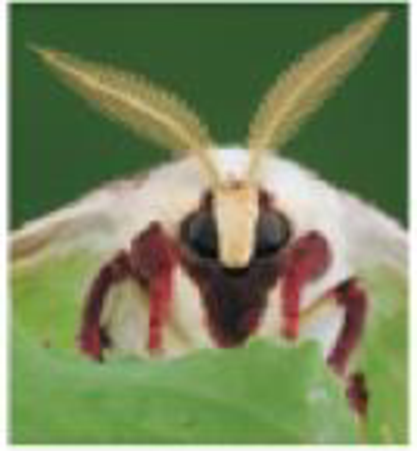
SCIENTIFIC INQUIRY

Female luna moths (Actias luna) attract males by emitting chemical signals that spread through the air. A male hundreds of meters away can detect these molecule and fly toward their source. The sensory organs responsible for this behavior are the tomblike antennae visible in the photograph shown here. Each filament of an antenna is equipped with thousands of receptor cells that detect the sex attractant. (a) Based on what you learned in this chapter, propose a hypothesis to account for the ability of the male moth to detect a specific molecule in the presence of many other molecules in the air. (b) Describe predictions your hypothesis enables you to make. (c) Design an experiment to test one of these predictions.
Want to see the full answer?
Check out a sample textbook solution
Chapter 2 Solutions
CAMPBELL BIOLOGY IN FOCUS-TEXT,AP ED.
Additional Science Textbook Solutions
BIOLOGY:THE ESSENTIALS (LL) W/CONNECT
Biological Science (6th Edition)
Human Anatomy & Physiology
Microbiology: An Introduction (13th Edition)
- An enzyme-linked receptor (a) is a cytoplasmic protein (b) would not be found on plant cell surfaces (c) forms a dimer with another enzyme-linked receptor when a ligand binds to it (d) is typically an adenylyl cyclase molecule(e) typically activates ion channelsarrow_forwardCascading effect occurs when a signal is receive by the receptor ( " turned on" ) but how do cells turns off a signal?arrow_forwardα-Bungarotoxin is a powerful neurotoxin found in the venom of a poisonous snake (Bungarus multicinctus). It binds with high specificity to the acetylcholine receptor (AChR; an integral membrane protein) andprevents its ion channel from opening. This interaction was used to purify AChR from the electric organ of torpedo fish.(a) Outline a strategy for using α-bungarotoxin covalently bound to chromatography beads to purify the AChR protein. (b) Outline a strategy for the use of [125I]α-bungarotoxin to purify the AChR protein.arrow_forward
- Same question but two different sectionsarrow_forwardKnowledge Check Use of Microscopes You are going to learn how to use the most common type of microscope, the compound light microscope. K The following question will be scored. Which of the following scientific investigations may use a compound light microscope? (check all that apply) Detect the presence or absence of a nucleus (large organelle) in cells of unknown origin. L 9c3/c7405a10-23cb-11ed-b26a-dfb355b4f1e5/c785043... Determine the diversity of microbes in a lagoon to monitor recovery after pollution. Decipher whether snakes detect their prey through sound, smell, sight, touch, or a combination of senses. Identify red blood cells in a patient suspected to have sickle cell anemia, in which red blood cells are sickle shaped. Examine the corona, or protein spikes, on the outside of the COVID-19 (SARS-CoV-2) virus. MacBook Pro SUBMIT ->arrow_forwardPlease help me, idk if my answer is correct and I am trying to use this to study!!arrow_forward
- According to data from genome sequences, cytoplasmic dynein is absent in some plants (e.g.,Arabidopsis) and present in others (e.g.,rice).Does this finding surprise you? What else might you do to confirm or refute such a statement? How is it possible that higher plant cells could operate without cytoplasmic dynein?arrow_forwardData Table: Comparison of Mammalian Species (Humans, Mice, Cats, and Baboons) Test 6 Number of Differences in DNA base sequence for DATP gene * 1 4 Mouse Cat Baboonarrow_forwardHow could telemedicine be a part of PHM model?arrow_forward
- In a study published in Science, Premack and Woodruff asked: "To what extent does the chimpanzee comprehend the elements of a problem situation and potential solutions?" An adult chimpanzee (Sarah) was shown 30-second videotapes of a human actor struggling with one of several problems (for example, not able to reach bananas hanging from the ceiling, a record player not playing). Then Sarah was shown two photographs, one that depicted a solution to the problem (like stepping onto a box, plugging in the record player) and one that did not. She was then instructed to pick one of the photos and place it under the television monitor. (Sarah had been raised in captivity since age one and had extensive prior exposure to photographs and television.) The order in which the scenes were presented to Sarah was randomized, as was the left/right position of the photos presented to her. Sarah was shown eight different scenarios. For each scenario, researchers recorded whether Sarah selected the…arrow_forwardDo a concept maparrow_forwardSame question but two different sectionsarrow_forward
 Biology (MindTap Course List)BiologyISBN:9781337392938Author:Eldra Solomon, Charles Martin, Diana W. Martin, Linda R. BergPublisher:Cengage Learning
Biology (MindTap Course List)BiologyISBN:9781337392938Author:Eldra Solomon, Charles Martin, Diana W. Martin, Linda R. BergPublisher:Cengage Learning
